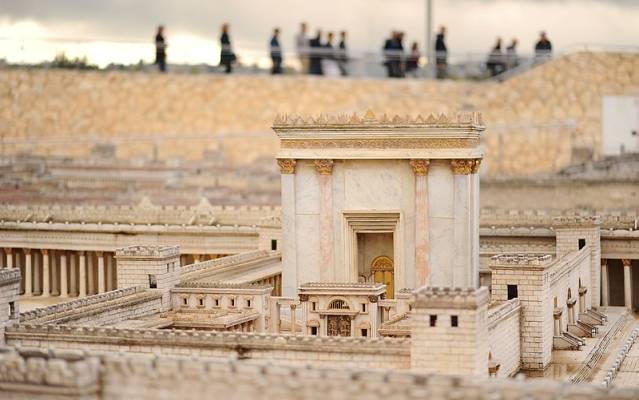With Tisha b’Av, the day of mourning for the Holy Temple, almost upon us, it’s time to brush up on the importance of Jerusalem, and in this case, the Temple and the Temple Mount – the focal point of Jerusalem.
By Rabbi Ari Enkin, Rabbinic Director, United with Israel
The First and Second Temples stood in Jerusalem on Har Habayit, the Temple Mount, known as Mount Moriah throughout the Bible. Today there is the familiar gold domed mosque which occupies the site.
Contrary to popular widespread misconception, the Holy Temple was much more than a synagogue. It was the center of all Jewish life, both spiritual and material.
From the High Priest and the High Court to the shops and money changers along its outer promenade, the Holy Temple was the pulse of Jewish life in Jerusalem, and by extension, the entire world.
According to Jewish tradition, the creation of the world began from the Temple Mount. Furthermore, God used earth from the Temple Mount to create Adam and Eve. According to some accounts, the first sacrifices that Noah offered after disembarking from the Ark were at the Temple Mount.
It was also the site of the Akeida, the binding and near sacrifice of Isaac on the Altar by his father, Abraham, at the command of God. In fact, this event took place on the “rock” that can be seen today in the Dome of the Rock mosque.
The Bible tells us that the First Temple was built in 957 BCE by King Solomon. Before this time people were permitted to offer sacrifices to God at any time and place, even in their own backyard. Once the Temple was completed, it became forbidden to offer sacrifices anywhere else.
Temple Replaced the Tabernacle of the Desert
The Temple replaced the Tabernacle, the portable synagogue that accompanied the Jewish people during their 40 years of wandering in the desert, as well as in the Land of Israel until the Temple was built. The First Temple was destroyed by the Babylonians in 586 BCE.
According to the Book of Ezra, construction of the Second Temple was authorized by King Cyrus and began in 538 BCE, after the fall of the Babylonian Empire the previous year. It was completed 23 years later, on the third day of Adar, in the sixth year of the reign of Darius the Great (12 March 515 BCE).
The dedication ceremony was led by the Jewish governor Zerubbabel. The main courtyard had 13 gates from which one was able to access the Temple and the Temple Mount.
The Second Temple was nearly destroyed in 332 BCE, when the Jews refused to acknowledge the deification of Alexander the Great of Macedonia. Alexander was allegedly “turned from his anger” at the last minute by some astute diplomacy and flattery.
After the death of Alexander on 13 June 323 BCE, the Ptolemies came to rule over Judea and the Temple. Under the Ptolemies, the Jews were given many civil liberties and lived contently under their rule.
However, when the Ptolemaic army was defeated by Antiochus III of the Seleucids in 198 BCE, this policy changed. Antiochus wanted to Hellenize the Jews. A rebellion ensued and was brutally crushed, but no further action by Antiochus was taken.
Jewish Rebellion against Antiochus III
Antiochus IV Epiphanies immediately adopted his father’s previous policy of universal Hellenization. The Jews rebelled again and Antiochus, in a rage, retaliated in force.
The straw that broke the camel’s back for the Jewish people was when Antiochus outlawed the observance of the Sabbath and brit milah – circumcision. Additionally, when Antiochus erected a statue of Zeus in the Temple and Hellenic priests began sacrificing pigs (the usual sacrifice offered to the Greek gods in the Hellenic religion), the Jews’ anger began to spiral.
When a Greek official ordered a Jewish priest to perform a Hellenic sacrifice, the priest, Mattathias, killed him.
In 167 BCE the Jews rose up en masse behind Mattathias and his five sons to fight and win their freedom from Seleucid authority. Mattathias’ son, Judas Maccabeus, rededicated the temple in 165 BCE, and the Jews celebrate this event to this day as a major part of the festival of Chanukah.
During the Roman occupation of Judea, the Temple remained under control of the Jewish people. It was later destroyed by the Romans in 70 CE during the Siege of Jerusalem.
During the last revolt of the Jews against the Romans in 132-135 CE, Simon bar Kokhba and Rabbi Akiva wanted to rebuild the Temple, but bar Kokhba’s revolt failed and the Jews were banned from Jerusalem
After the Muslim conquest of Jerusalem in the 7th century, Umayyad Caliph Abd al-Malik ibn Marwan ordered the construction of an Islamic shrine, known today as the Dome of the Rock, on the site of the Temple. The shrine has stood on the mount since 691 CE.
The al-Aqsa Mosque, from roughly the same period, also stands in the Temple courtyard. The Temple Mount, along with the entire Old City of Jerusalem, was captured from Jordan by Israel in 1967 during the Six Day War, allowing Jews once again to pray at the holy site since 1948.
Traditional Service Largely Unchanged Since Temple Times
Much of the traditional Jewish morning service, especially the Shema and Shemoneh Esrei (the silent devotional prayer), is largely unchanged since tthe daily worship service in the Temple.
In addition, the Shemoneh Esrei was given new meaning in that it corresponds to and recalls the Temple’s daily offering.
The Holy Temple is mentioned extensively in Orthodox services, including:
A daily recital of Biblical and Talmudic passages related to the sacrifices performed in the Temple;
References to the restoration of the Temple and sacrificial worships in the thrice daily Shemoneh Esrei;
A plea for the reconstruction and restoration of the Temple at a number of points in each of the three daily services; and
The recitation of the Psalm of the day – the psalm sung by the Levites in the Temple for that day during the daily morning service.
Orthodox Judaism: Rebuilding the Temple
Orthodox Judaism believes in the future building of a Third Temple and the resumption of the offerings, although there is disagreement about how the rebuilding should take place.
Most rabbinic authorities believe that the rebuilding of the Temple should only be undertaken by the Messiah in the Messianic era, though some believe that the Jewish people should rebuild the Temple themselves. According to another teaching, God Himself will send down the Third and Final Temple from Heaven.
Well-known for his controversial positions concerning Jewish sovereignty over the Temple Mount, Rabbi Shlomo Goren, chief rabbi of the IDF (and later chief rabbi of the State of Israel) after Israel’s capture of the Mount in 1967, began organizing public prayer for Jews on the site.
On August 15, 1967, Rabbi Goren led a group of 50 Jews onto the Temple Mount; fighting off protesting Muslim guards and Israeli police, they defiantly held a prayer service. Rabbi Goren continued to pray for many years in a building overlooking the Temple Mount, where he conducted yearly High Holiday services.
His call for the establishment of a synagogue on the Temple Mount has subsequently been reiterated by his brother-in-law, Chief Rabbi of Haifa She’ar Yashuv Cohen.
REBUILD ISRAELI FARMS DESTROYED BY HAMAS - PLANT TREES!
ISRAELI FARMERS DESPERATELY NEED YOUR YOUR HELP
Hamas tried to destroy everything. Terrorists murdered 1200 innocent Israelis. Join us in planting 12,000 trees of life to honor the victims. Send blessing to the People and Land of Israel.
“…I will ordain My blessing for you…” (Leviticus 25:4,21)
JOIN OUR CAMPAIGN TO PLANT 12,000 NEW FRUIT TREES ACROSS THE LAND OF ISRAEL!




